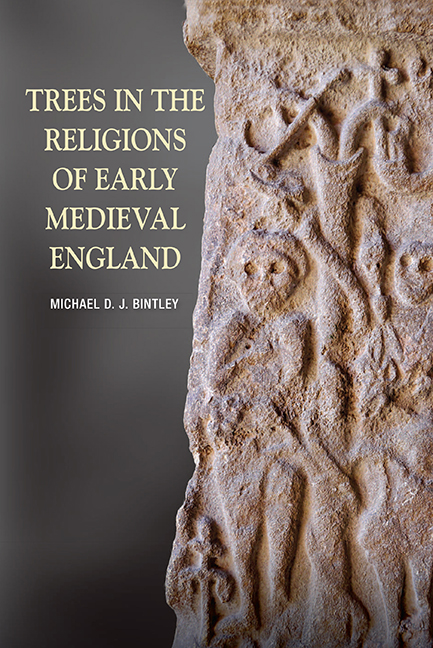Book contents
- Frontmatter
- Contents
- List of Illustrations
- Acknowledgements
- Introduction
- 1 Holy Trees and Inculturation in the Conversion Period
- 2 Anglo-Saxon Holy Trees and their Northern European Counterparts
- 3 Rewriting the Holy Rood in Anglo-Saxon Spiritual History
- 4. The Human Forest: People and Trees in Early Medieval England and Scandinavia
- Summary
- Bibliography
- Index
- Anglo-Saxon Studies
2 - Anglo-Saxon Holy Trees and their Northern European Counterparts
Published online by Cambridge University Press: 11 June 2021
- Frontmatter
- Contents
- List of Illustrations
- Acknowledgements
- Introduction
- 1 Holy Trees and Inculturation in the Conversion Period
- 2 Anglo-Saxon Holy Trees and their Northern European Counterparts
- 3 Rewriting the Holy Rood in Anglo-Saxon Spiritual History
- 4. The Human Forest: People and Trees in Early Medieval England and Scandinavia
- Summary
- Bibliography
- Index
- Anglo-Saxon Studies
Summary
The Introduction discussed the role of trees in Anglo-Saxon pre-Christian belief, and those customs associated with holy trees that were later forbidden by the Church. In Chapter 1 I presented three cases from the conversion era in which missionaries pursuing an inculturative method of Christianisation directly engaged with pre-Christian beliefs about trees and their derivatives. It is at these points of incidence between Roman Christianity and insular heathenism, which allowed the conversion to take place on an inculturative basis, where the characteristics of trees in pre-Christian belief are most likely to be found. This chapter will begin by identifying these potential aspects of trees’ religious symbolism before going on to outline their continuing secular function in the Anglo-Saxon political landscape, both before and after Christianity was well established. This is followed by a comparative discussion of trees, posts, pillars and associated traditions elsewhere in the sphere of ‘Germanic’ religious influence. The argument is structured in this way in order to avoid searching for evidence in Anglo-Saxon England on the basis of continental or Scandinavian analogues and working backwards, as is the customary method. The aim here is to foreground the evidence from insular contexts rather than to impose it from elsewhere.
A number of aspects of pre-Christian symbolism associated with trees can be determined from insular evidence which, as this book aims to show, were maintained in Anglo-Saxon Christianity after the conversion. These can be outlined by briefly returning to the three groups of objects and concepts discussed in the previous chapter. The prominence of the wooden ritual posts at Yeavering, one of the most pre-eminent seats of Anglian authority in Bede's Historia and in the archaeological record, indicates that they were associated with earthly and supernatural power at a high level. The posts in this place served a religious purpose of one sort or another, with their alignment determining that of the central buildings whose function was Yeavering's raison d’être. They may in some way have mediated between the human and the divine, and could have been closely connected with the manner in which divine order was upheld at Yeavering. The religious power of posts like these is reaffirmed by monuments like the Ruthwell and Bewcastle crosses, whose vine-scroll ornament also indicates that posts, pillars and Christian crosses continued to be associated with trees, both by name and through their Romanised physical forms.
- Type
- Chapter
- Information
- Trees in the Religions of Early Medieval England , pp. 69 - 90Publisher: Boydell & BrewerPrint publication year: 2015



